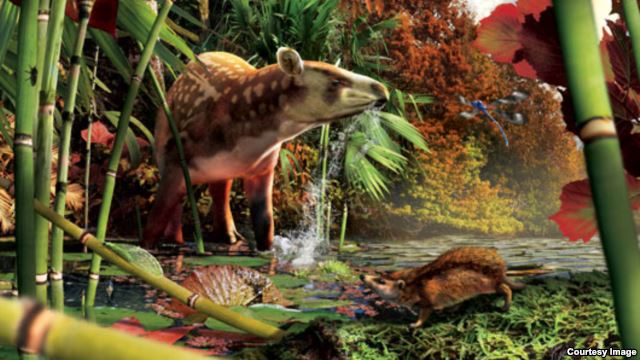We reach more than 65,000 registered users in Dec!! Register Now

Fossils of tiny, unknown hedgehog found
- July 14, 2014
- 819 Views
- 0 Likes
- 0 Comment
Meet per≠haps the ti≠ni≠est hedge≠hog spe≠cies ev≠er:†Sil≠va≠cola acares.†Its roughly 52-mil≠lion-year-old fos≠sils were iden≠ti≠fied by re≠search≠ers in≠ves≠ti≠gat≠ing a "lost world" of fos≠sil≠ized for≠est in Can≠a≠da. The hedge≠hog's sci≠en≠tif≠ic name means "ti≠ny for≠est dweller," said Jae≠lyn Eberle of the Uni≠vers≠ity of Col≠o≠rad≠o Boul≠der, lead au≠thor of the stu≠dy. The crea≠ture was only about ...
Meet per≠haps the ti¬≠ni¬≠est hedge¬≠hog spe¬≠cies ev¬≠er:¬†Sil¬≠va¬≠cola acares.¬†Its roughly 52-mil¬≠lion-year-old fos¬≠sils were iden¬≠ti¬≠fied by re¬≠search¬≠ers in¬≠ves¬≠ti¬≠gat¬≠ing a ‚Äúlost world‚ÄĚ of fos¬≠sil¬≠ized for¬≠est in Can¬≠a¬≠da.
The hedge¬≠hog's sci¬≠en¬≠tif¬≠ic name means ‚Äúti¬≠ny for¬≠est dweller,‚ÄĚ said Jae¬≠lyn Eberle of the Uni¬≠vers¬≠ity of Col¬≠o¬≠rad¬≠o Boul¬≠der, lead au¬≠thor of the stu¬≠dy. The crea¬≠ture was only about two inches long, roughly the length of an adult thumb.
It is ‚Äúcom¬≠pa¬≠ra¬≠ble in size to some of to¬≠day's shrews,‚ÄĚ Eberle said. She spec¬≠u¬≠lat¬≠ed¬†Sil¬≠va¬≠cola¬†may have fed on in¬≠sects, plants and per¬≠haps seeds. Did it have quills like mod¬≠ern hedge¬≠hogs? ‚ÄúWe can't say for sure,‚ÄĚ Eberle said. ‚ÄúBut there are an¬≠ces¬≠tral hedge¬≠hogs liv¬≠ing in Eu¬≠rope about the same time that had bristly hair cov¬≠er¬≠ing them, so it is plau¬≠si¬≠ble¬†Sil¬≠va¬≠cola¬†did too.‚ÄĚ
Hedge­hogs have be­come quite the rage as pets in North Amer­i­ca in the past sev­eral years. The most com­mon hedge­hog pet to­day is the Af­ri­can pyg­my hedge­hog, which is up to four times the length of the di­min­u­tive Sil­va­cola.
The fos­sils of the hedge­hog, along with fos­sils of a ta­pir-like mam­mal about the size of a me­di­um-sized dog, were found in north-central Brit­ish Co­lum­bia at a site known as Drift­wood Can­yon Pro­vin­cial Park that likely was a rainfor­est en­vi­ron­ment dur­ing the Early Eo­cene Ep­och about 52 mil­lion years ago, she said.
While the Earth has ex­pe­ri­enced many dra­mat­ic changes in cli­mate since the di­no­saurs died out 66 mil­lion years ago, the Early Eo­cene was one of the warmest pe­ri­ods on Earth since the ex­tinc­tion. Dur­ing this interval-a­bout 53 mil­lion to 50 mil­lion years ago-North Amer­i­can mam­mal com­mun­i­ties were quite dis­tinct from those of to­day, said Eberle.
A pa­per on the dis­cov­ery of the an­cient hedge­hog and ta­pir is be­ing pub­lished to­day in the Jour­nal of Ver­te­brate Pa­le­on­tol­ogy.
‚ÄúWithin Can¬≠a¬≠da, the only oth¬≠er fos¬≠sil lo¬≠cal¬≠i¬≠ties yield¬≠ing mam¬≠mals of si¬≠m¬≠i¬≠lar age are from the Arc¬≠tic, so these fos¬≠sils from Brit¬≠ish Co¬≠lum¬≠bia help fill a sig¬≠nif¬≠i¬≠cant ge¬≠o¬≠graph¬≠ic gap,‚ÄĚ said¬† Re¬≠search Sci¬≠ent¬≠ist Na¬≠tal¬≠ia Ry¬≠bczyn¬≠ski of the Ca¬≠na¬≠di¬≠an Mu¬≠se¬≠um of Na¬≠ture in Ot¬≠ta¬≠wa, On¬≠tar¬≠i¬≠o, a co-au¬≠thor of the stu¬≠dy.
Oth­er fos­sils of the same age have pre­vi­ously been dis­cov­ered in Wy­o­ming and Col­o­rad­o, she said. Mod­ern hedge­hogs and their rel­a­tives are re­strict­ed to Eu­rope, Asia and Af­ri­ca. The ti­ny hedge­hog's del­i­cate up­per teeth were scanned with­out be­ing re­moved from the sur­round­ing rock us­ing an in­dus­t­ri­al, high-resolution scan­ner at Penn State Uni­vers­ity.
The oth­er mam­mal dis­cov­ered at the site, Hep­todon, is an an­cient rel­a­tive of mod­ern ta­pirs, which re­sem­ble small rhi­nos with no horns and a short, mo­bile trunk or pro­bos­cis, said Eberle, al­so cu­ra­tor for ver­te­brate pa­le­on­tol­ogy at the Uni­vers­ity of Col­o­rad­o Mu­se­um of Na­ture and Sci­ence.
‚ÄúHep¬≠todon¬†was about half the size of to¬≠day's ta¬≠pirs, and it lacked the short trunk that oc¬≠curs on lat¬≠er spe¬≠cies and their liv¬≠ing cous¬≠ins,‚ÄĚ said Eberle. ‚ÄúBased up¬≠on its teeth, it was probably a leaf-eater, which fits nicely with the rainfor¬≠est en¬≠vi¬≠ron¬≠ment in¬≠di¬≠cat¬≠ed by the fos¬≠sil plants at the site.‚ÄĚ
Most of the fos­sil-bearing rocks at Drift­wood Can­yon were formed on the bot­tom of an an­cient lake and are well known for their ex­cep­tion­ally well-pre­served leaves, in­sects, and fish­es. But no fos­sils of mam­mals had ev­er be­fore been iden­ti­fied at the site.
‚ÄúThe dis¬≠cov¬≠ery in north¬≠ern Brit¬≠ish Co¬≠lum¬≠bia of an early cous¬≠in to ta¬≠pirs is in¬≠tri¬≠guing be¬≠cause to¬≠day's ta¬≠pirs live in the trop¬≠ics,‚ÄĚ said Eberle. ‚ÄúIts oc¬≠cur¬≠rence, alongside a di¬≠vers¬≠ity of fos¬≠sil plants that in¬≠di¬≠cates a rainfor¬≠est, sup¬≠ports an idea put for¬≠ward by oth¬≠ers that ta¬≠pirs and their ex¬≠tinct kin are good in¬≠di¬≠ca¬≠tors of dense for¬≠ests and high pre¬≠cipita¬≠t¬≠ion.‚ÄĚ
Fos­sil plants from the site in­di­cate the ar­ea sel­dom ex­pe­ri­enced freez­ing tem­per­a­tures and probably had a cli­mate si­m­i­lar to that of con­tem­po­rary Port­land, Ore., roughly 700 miles to the south.
‚ÄúDrift¬≠wood Can¬≠yon is a win¬≠dow in¬≠to a lost world, an ev¬≠o¬≠lu¬≠tion¬≠ary ex¬≠pe¬≠ri¬≠ment where palms grew be¬≠neath spruce trees and the in¬≠sects in¬≠clud¬≠ed a mix¬≠ture of Ca¬≠na¬≠di¬≠an and Aus¬≠tral¬≠ian spe¬≠cies. Discov¬≠er¬≠ing mam¬≠mals al¬≠lows us to paint a more com¬≠plete pic¬≠ture of this lost world,‚ÄĚ said Green¬≠wood.
‚ÄúThe early Eo¬≠cene is a time in the ge¬≠o¬≠log¬≠i¬≠cal past that helps us un¬≠der¬≠stand how pre¬≠s¬≠ent-day Can¬≠a¬≠da came to have the tem¬≠per¬≠ate plants and an¬≠i¬≠mals it has to¬≠day,‚ÄĚ Green¬≠wood said. ‚ÄúHowev¬≠er, it can al¬≠so help us un¬≠der¬≠stand how the world may change as the glob¬≠al cli¬≠mate con¬≠tin¬≠ues to war¬≠m.‚ÄĚ
Source : world-science.net









